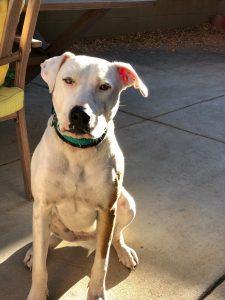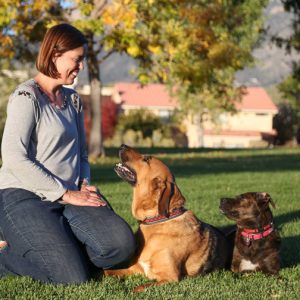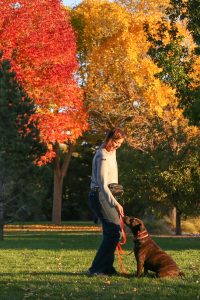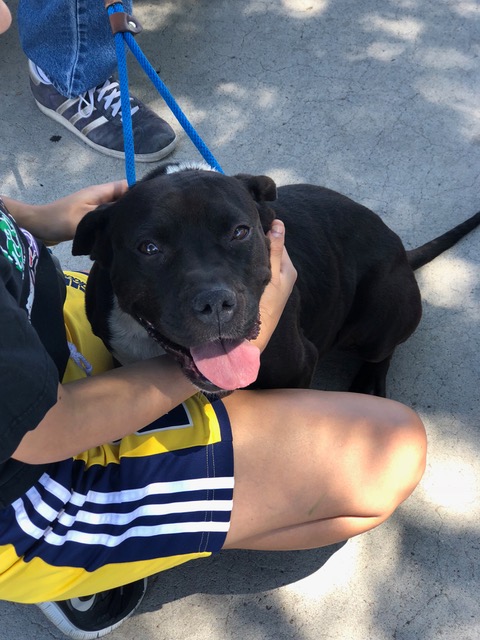Best Dogs For Kids. Adopting a dog is one of the few times we can choose a family member. When people think of having a dog, they usually have visions of walking, hiking, going to an outdoor café, and just hanging out with a best friend. They want their dog and children to be best buddies. Unfortunately, this doesn’t always happen. As a dog trainer, I speak with many clients that just adopted a dog that bit their child, guards their food bowl, or tore up their house, due to anxiety. Choosing a dog is not simple anymore…
There are many places to get a dog – like dog rescues, breeders, and shelters. Some people trying to sell or adopt people a dog don’t have the buyer’s or adopter’s best interest at heart. The knowledge of dog rescue and shelter personnel varies, so I recommend adopters learn about how to choose a dog and decide for themselves. How does an average dog adopter sift through all the options and available dogs to find the match for them?
Genetic Temperament
It all boils down to determining a dog’s genetic temperament and choosing the temperament that matches your family. A dog’s innate temperament is important because it is the foundation of the dog’s behavior and personality. The statement, “Its all how you raise them,” meaning that if you raise a dog with a good home, love, and some training, he will be a good family dog, is far from the truth. As a dog rescuer and dog foster mom (I wear two hats in the dog world), I have witnessed many, many dogs that suffered horrendous living conditions and abuse that are still wonderful friendly dogs. As a dog trainer, I know of dogs that had nothing but a loving home that are unstable, aggressive, or anxious. While a loving home with proper boundaries and training will provide a dog the best chance at being a nice dog, it does not guarantee it. A dog is a sentient, individual living creature born with its own DNA and genetics. Genetic innate temperament is the reason police and service dog breeding programs are so selective. Innate temperament is why we cannot take a Coonhound and make it herd sheep. (Well, maybe we could, but it would be very difficult.) When choosing your family dog, pay a lot of attention to the dog’s temperament it is born with, not its history, size, or appearance. Use logic and instinct to choose a dog instead of pure emotion, pity, or physical attraction. The cutest dog with blue eyes may not be the right temperament for your family.
 The temperament that makes a nice family dog is a dog that wants to be with people, is somewhat submissive, and has low prey drive without a high level of anxiety or fear. To find this kind of dog at an adoption event or a breeder’s location, start by observing from afar. Locate the dogs that are engaging with people with a low to medium height, wagging tail. A dog that is somewhat fearful or insecure should still have a desire to be with people to be easy to rehabilitate. A polite dog that is sitting or standing nicely while being petted is typically easier for an average pet guardian than a dog forcefully jumping off of people or wrapping its legs around a person. Forceful jumping or wrapping legs is more dominant behavior, although some dogs will lightly jump if they have been encouraged to do so by other people. One side note: do not give treats or food to dogs you are considering adopting as this will sway their interest in you and may create misleading results. A dog that comes up to you, sniffs and walks away, or jumps on you and walks away is usually a bit aloof and better for an adult home or more experienced dog owner. Aloof dogs are harder to train and care less about what their guardians want from them. Aloofness may be good in some situations if the dog is home alone a lot or someone desires a more independent dog. Consider hiring a few sessions with an animal behaviorist as well.
The temperament that makes a nice family dog is a dog that wants to be with people, is somewhat submissive, and has low prey drive without a high level of anxiety or fear. To find this kind of dog at an adoption event or a breeder’s location, start by observing from afar. Locate the dogs that are engaging with people with a low to medium height, wagging tail. A dog that is somewhat fearful or insecure should still have a desire to be with people to be easy to rehabilitate. A polite dog that is sitting or standing nicely while being petted is typically easier for an average pet guardian than a dog forcefully jumping off of people or wrapping its legs around a person. Forceful jumping or wrapping legs is more dominant behavior, although some dogs will lightly jump if they have been encouraged to do so by other people. One side note: do not give treats or food to dogs you are considering adopting as this will sway their interest in you and may create misleading results. A dog that comes up to you, sniffs and walks away, or jumps on you and walks away is usually a bit aloof and better for an adult home or more experienced dog owner. Aloof dogs are harder to train and care less about what their guardians want from them. Aloofness may be good in some situations if the dog is home alone a lot or someone desires a more independent dog. Consider hiring a few sessions with an animal behaviorist as well.
 After spotting a nice friendly dog that wants to be with people, walk over to it and pet it. Pet the dog under the chin, not on top of the head. Pet the dog on his back a little. Stop petting and see if the dog hangs out with you for more affection. The dog walking over to another person for affection and being social with many people is also good sign. If the dog is not interested in you and walks away or avoids you by sniffing items, I would look at other dogs. For a home with children, the dog that is naturally polite with children is optimal. I don’t want the dog to immediately jump up, nip, or avoid the kids. Polite interest is best.
After spotting a nice friendly dog that wants to be with people, walk over to it and pet it. Pet the dog under the chin, not on top of the head. Pet the dog on his back a little. Stop petting and see if the dog hangs out with you for more affection. The dog walking over to another person for affection and being social with many people is also good sign. If the dog is not interested in you and walks away or avoids you by sniffing items, I would look at other dogs. For a home with children, the dog that is naturally polite with children is optimal. I don’t want the dog to immediately jump up, nip, or avoid the kids. Polite interest is best.
 The next step is to assess how sensitive and accepting the dog is of touch. Touch the dog’s teeth, ears, feet, tail in a gentle, calm manner**. I want the dog to either accept this touch or lick my hand. I assess plenty of dogs that are in pain with bad hips and rotten teeth that will not snap at me for touching their hips or mouth, so pain is not an excuse to bite when doing this kind of touch. If the dog bites, growls, gives you a hard stare, or stiffens, move on to another dog if you have children. If you have young children you want a dog that will not bite when your child accidentally steps on his tail or falls on his leg. Dogs that are more sensitive to touch are better for adult homes that will be able to recognize a dog’s comfort level better.
The next step is to assess how sensitive and accepting the dog is of touch. Touch the dog’s teeth, ears, feet, tail in a gentle, calm manner**. I want the dog to either accept this touch or lick my hand. I assess plenty of dogs that are in pain with bad hips and rotten teeth that will not snap at me for touching their hips or mouth, so pain is not an excuse to bite when doing this kind of touch. If the dog bites, growls, gives you a hard stare, or stiffens, move on to another dog if you have children. If you have young children you want a dog that will not bite when your child accidentally steps on his tail or falls on his leg. Dogs that are more sensitive to touch are better for adult homes that will be able to recognize a dog’s comfort level better.
Go For A Walk
Next take the dog for a walk. Change directions a few times and see if the dog follows you somewhat. Precise leash walking is not important, just the desire to follow a person. If the adopter turns the opposite way the dog is going, the dog will somewhat follow them after a couple turns. The easier the dog follows you the easier it will be to train. Observe if the dog is scared of any environmental things such as other people, strollers, bicycles, flags, or loud noises. If the dog startles to a dropping clipboard or metal water bottle, then comes to sniff it and moves on, that is desirable. If the dog gets scared and walks away or only investigates the object with coaxing, this dog is less confident and will require some rehabilitation and patience to become more confident. A dog that cannot recover and remains stuck in fear or runs away and will not return is a case for skilled professionals to help before adoption. A fearful dog may not be a good match for small children as kids can be erratic and noisy at times. If the dog has a lot of energy, make sure you have enough time and energy to fulfill the dog’s needs. Runners, hikers, and active people are best for high-energy dogs.
 There are red flags to watch out for when adopting a dog. One is resource guarding, which is a dog that may growl or bite over toys and food. Resource guarding can be a serious problem and safety risk. Any dog put in a home with small children should be tested for resource guarding carefully. This is done by giving the dog a treat like a bone and approaching the dog**. A dog that stiffens, give a hard look, growls, bares teeth, or bites should not be placed with children, or most adults for that matter. Another red flag is outright aggressive behavior such as growling or biting. A dog with this behavior is going to be a difficult dog for the average adopter. A dog with fear to the point of being frozen, not liking people, or growling at people needs to be rehabilitated and trained before being adopted to the public.
There are red flags to watch out for when adopting a dog. One is resource guarding, which is a dog that may growl or bite over toys and food. Resource guarding can be a serious problem and safety risk. Any dog put in a home with small children should be tested for resource guarding carefully. This is done by giving the dog a treat like a bone and approaching the dog**. A dog that stiffens, give a hard look, growls, bares teeth, or bites should not be placed with children, or most adults for that matter. Another red flag is outright aggressive behavior such as growling or biting. A dog with this behavior is going to be a difficult dog for the average adopter. A dog with fear to the point of being frozen, not liking people, or growling at people needs to be rehabilitated and trained before being adopted to the public.
More Red Flags
Another red flag is a rescue or breeder that makes excuses for the dog’s behavior. Dogs are amazingly resilient creatures. A dog that is outgoing and confident will not become overly scared or aggressive in a new situation. A stable dog will take only a few minutes to investigate and become comfortable in his new surroundings. A puppy hiding in the corner is a fearful puppy. A normal puppy will investigate a new place immediately. There are diamonds in the rough out there, but those dogs will require patience and they do show signs of liking people if ever so slightly. These dogs take time and can be extremely rewarding to help, but make sure you have the time and family to help that dog succeed.

Did you find this article useful? Would you like 100% free access to more articles like these, and free access to over 5,000 vetted pet care service professionals throughout the United States? Sign up here for a free Petworks account, and take 10% off your first booking, on us!
When looking for a dog, use the above recommendations and don’t be in a rush to choose a dog that will be in your house for over a decade. A good dog is worth the time he takes to find.
**As always be very cautious and use good judgment when touching or evaluating dogs. Any interaction with animals can be inherently dangerous.
About the Author:
 Julie Hart is the founder of Hart to Heart Canine Training, offering in-home private consultations and dog training lessons. She is a Professional Member and Certified Dog Trainer of the International Association of Canine Professionals, and a trainer on staff for a local rescue organization. Julie has presented twice at the International Association of Canine Professionals national conference. She received a scholarship to Training Cesar’s Way, and gives classes for foster dog parents.
Julie Hart is the founder of Hart to Heart Canine Training, offering in-home private consultations and dog training lessons. She is a Professional Member and Certified Dog Trainer of the International Association of Canine Professionals, and a trainer on staff for a local rescue organization. Julie has presented twice at the International Association of Canine Professionals national conference. She received a scholarship to Training Cesar’s Way, and gives classes for foster dog parents.
About Us
 In 2021, Dr. Marty Goldstein DVM joined the pet care platform Petworks as an advisor in its Animal Nutrition care division. Dr Marty Nature’s Blend is on a mission to help your pets live their healthiest lives possible. Dr. Marty’s pet nutrition expertise and guidance has helped Petworks evolve and become the preeminent animal and pet nutrition consultation service for pet parents in North America.
In 2021, Dr. Marty Goldstein DVM joined the pet care platform Petworks as an advisor in its Animal Nutrition care division. Dr Marty Nature’s Blend is on a mission to help your pets live their healthiest lives possible. Dr. Marty’s pet nutrition expertise and guidance has helped Petworks evolve and become the preeminent animal and pet nutrition consultation service for pet parents in North America.
 In 2022, Blue Buffalo Founder Bill Bishop Jr. joined Petworks as Senior Advisor in our Animal Nutrition Care Division. Bill brings his extensive expertise in pet food innovation and business leadership. His guidance helps Petworks enhance our pet nutrition service offerings, helping to ensure that pet parents throughout the world receive trusted, science-backed nutritional support for their dogs, cats, and animals.
In 2022, Blue Buffalo Founder Bill Bishop Jr. joined Petworks as Senior Advisor in our Animal Nutrition Care Division. Bill brings his extensive expertise in pet food innovation and business leadership. His guidance helps Petworks enhance our pet nutrition service offerings, helping to ensure that pet parents throughout the world receive trusted, science-backed nutritional support for their dogs, cats, and animals.
Petworks Co-Founder Kevin Kinyon is a life-long animal lover who works tirelessly to improve the lives of pets and their parents. Human and animal qualities he values most are integrity, humor, and empathy.




Thank you for this one, Petworks!